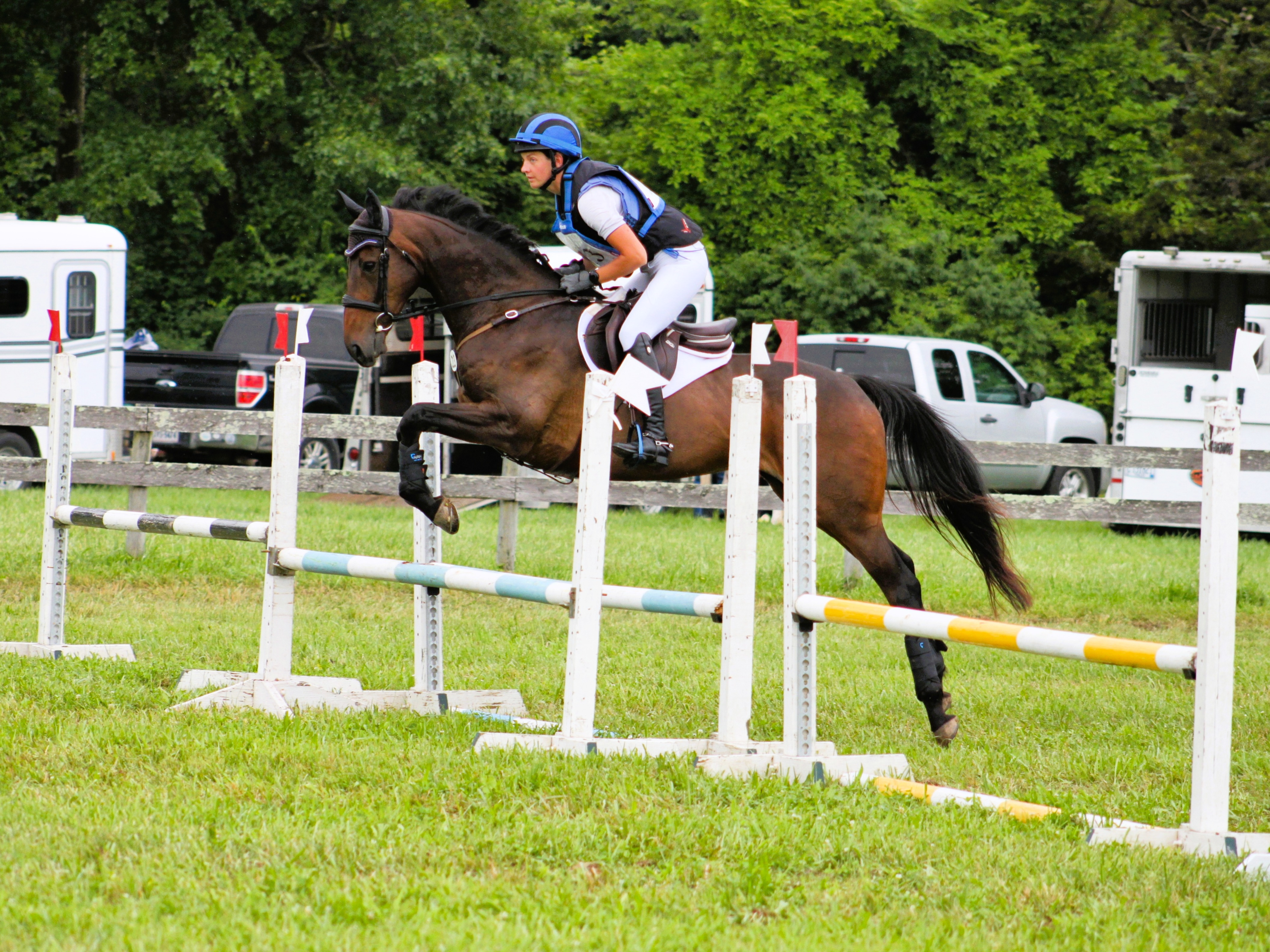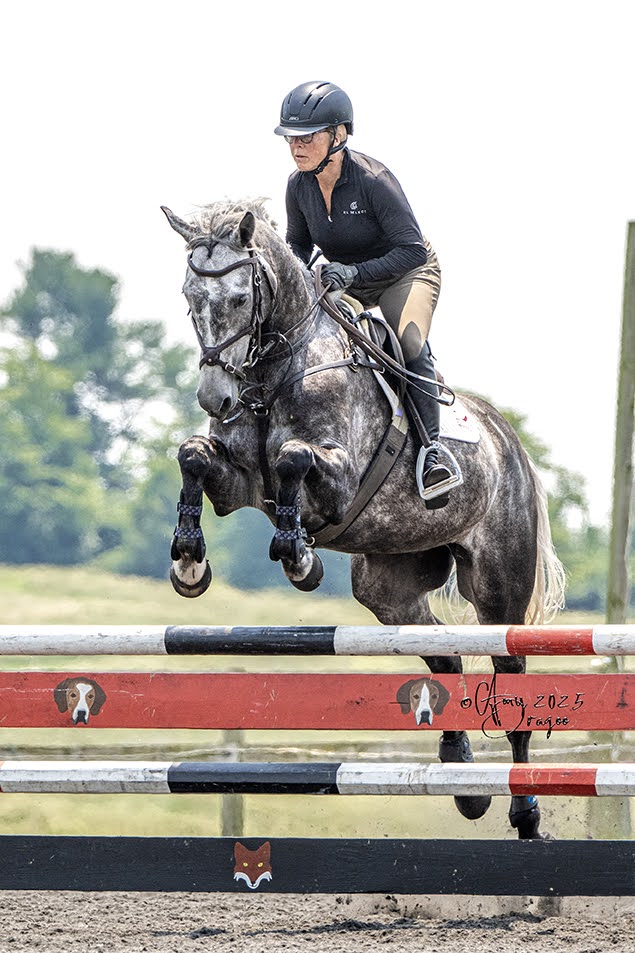
Nicki Henley enjoying his favorite view. Photo by Cat Hill.
Grief is an odd emotion. It teaches you to be humble, about how well you know yourself, and about how you treat others. I have always found myself wondering at the public nature of some people’s grief. I am a private person, and don’t often feel the need to put myself on a stage of any sort. A groom’s behind-the-scenes nature suited me just fine. Yet here I am, writing.
Last summer, I wrote an article about realizing I may never ride my best friend, Nicki again. Several people reached out and asked how he was doing, so here is the final chapter of that story.
Growing up, horses were my constant. I was an awkward child — quite bad at reading social cues and making friends. My parents noticed my love of all things with fur, and especially ones with soft muzzles and brown eyes, so they bought me a fat, failed pulling pony. She was my best friend for years.
Almost immediately I realized I could read horses better than people. They made sense to me. The barns I rode at were rather uneducated in their horse care. We cleaned stalls occasionally, thought horses would “learn” not to dump their water buckets if we didn’t refill them until the next day once they tipped over.
I used to read Practical Horseman, Horse Illustrated and any horse books I could get my hands on cover-to-cover. I memorized the names, watched the Olympics on TV and dreamed. I couldn’t imagine knowing those horses. Yes, the riders were like celebrities to me, but the horses were like gods. My biggest goal was to be on the U.S. Equestrian Team.
Fast forward to my twenties, when I walked onto Willow Bend for the first time. Mara DePuy was a name I’d read as a kid. Nicki Henley was a horse that I’d read about in the Chronicle, a horse I’d seen from across the warm-up at shows. I remember walking into the barn, and disbelieving that I was going to be responsible for the care of these horses, especially the bright bay with the white eye and the attitude.
Over the next several years, he taught me how to be a groom — how to make a horse with a myriad of GI issues eat, how to hold on to a horse-shaped kite when a horse was on stall rest and needed hand walking, how to feel the start of skin funk before it takes over, how to listen to a horse who is so tough he won’t ever say “ow”. He also took me on my first team trip, and showed me that a goal re-invented could be just as rewarding as I’d dreamed.
When I left Virginia to return to my hometown in New York, I was ready. Grooming at the elite level is emotionally and physically draining, and I was ready to invest more time with my husband and family. The only drawback was saying goodbye to Nicki. I was so upset; he had become my best friend by then. My husband referred to him, only half in jest, as the other man. I saw him as frequently as I could, sneaking him treats at events and getting regular updates from Mara.
The spring after I left, he injured himself and his competitive career was over. Mara planned to rehab him and then let him live in her luxurious retirement field with her other old Advanced horses. Nicki hated that plan. He paced the fence line. He ran the field, he colicked himself. So Mara brought him in and started hacking him, and he immediately settled.
So a little under a year after I left, I got a call. I was going to be in Aiken working for Dr. Kevin Keane as his assistant for the winter. Did I want Nicki for the winter? He could only hack at the walk (which often meant walk, spin, spook, walk, repeat). My answer was a loud, emphatic yes. At the end of the Aiken season, Mara tearfully asked if I wanted to take him home to New York.
By then, I was used to being trusted with top horses. I was an experienced groom and vet tech to some of the best horses in the country. Yet being trusted with Nicki, to take him home, to call him mine, was an enormous gift. I spent the next several years in utter bliss.
Nicki was never an easy horse. He hated bugs and had to be brought in at first light in the summer. He also hated cold and could only tolerate a few short hours outside in the winter. He had difficult skin, which meant you could never skip his daily curry or risk having giant holes develop in his coat. He was prone to colic, so had to be carefully monitored.
Yet his leg got better, and he was able to do more than I could have ever hoped. I took him to some dressage shows, earning some very respectable scores. He even healed enough to go cross country schooling and compete at a few derby crosses. Jumping him made me feel invincible.
He had one scare, when he had a colic-like episode that turned into colitis-X, and I came very close to losing him. He spent over a week at Cornell but came back to me, and returned to himself.
Last spring, he looked great. He came through the winter fat, and shining, and strong. He was downright wild to ride, and I had to put draw reins on him for a couple rides just to have enough control to accomplish anything. At 22, it looked like we had years left.
Then we started having some problems. I spent the summer nursing him, lying to myself about how poor he looked. He was always a horse who lost condition easily, so I fooled myself into thinking it was just the stress of the regular trips to Cornell.
Then he fell, and it looked like he’d injured his pelvis. I realized I may never ride him again, but still refused to look at the reality of how poor my man looked. He went into shock one night, and I rushed him to Cornell, finally being forced to face the truth.
The staff at Cornell was amazing, and stabilized him, and we waited for bloodwork. The next morning, I walked into his stall and he looked comfortable and happy. I waited for the vet, but I already knew. She came and confirmed my worst fear — a fast-moving and nasty form of cancer. We made sure he was comfortable, took him home and had his regular vet come to put him down, to be buried in his favorite spot in his field.
It’s been five months, and I still struggle to write that. His blankets hang in the barn. His stall stands empty. His feed instructions are still on the board. For over 10 years, my day started and ended with Nicki, breakfast and night check. I framed my life around him, built the barn for him — with a giant corner stall he could hang his head out into the aisle, or out the window to see the house.
As I became a mother, I depended more than I knew on the time with him — the quiet moments currying and brushing, the rides into the dawn before the kids woke up, his breath on my neck, his habit of kissing my face with his lips curled back and his closed teeth touching my cheek.
I wanted to quit horses for months after I lost him. I went and taught my lessons, rode my clients horses, and hated it all. I eventually decided not to quit — it’s been my entire life — but that hasn’t made it easy. I can’t explain the hollow feeling in my life where he used to be. Horses have been the one constant in my life for over 30 years, and I’ve been trying to reconnect with that feeling.
A few weeks ago, I barn-sat for Daisy and Richard Trayford. They breed some really lovely youngsters, and for the first time since Nicki left, I felt a little of the old love. The weanlings would put their muzzles on my shoulders when I scratched their chests. The gigantic 4-year-old (who must be part Labrador for all his 17 hands) would walk in every night lipping the back of my head and tickling my head with his whiskers.
I remembered that a previous version of me had loved young horses. I always used to say that if I were to have my dream horse job, it would be as an equine kindergarten teacher, taking horses from weanling to 4 and starting their life with people.
So as soon as winter clears out, I plan on getting a young project — something to re-sell, not one to keep. I am not naive enough to believe that I will find what I had with Nicki, possibly not ever again. My relationship to horses prior to him was rewarding and I had several horses I loved, so now I will try to find my way back to that.
It’s as if my life with horses has been climbing a mountain — the view is amazing halfway up the climb, if you’ve never been to the top. So now I will put on my boots, thread the belt with his name and hair woven into it through my breeches, and walk back down the trail and look out, and I’ll try to appreciate the view from a lower elevation.































